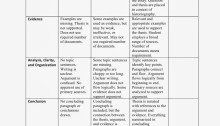Using a Grading Rubric to Evaluate Writing Assignments
For the past two years I have been using a grading rubric for writing assignments in all of my courses. In my first few years of teaching I was reluctant to consider using a rubric. I thought a rubric would place burdensome limits on my subjective leeway in assigning grades for writing. And wouldn’t a…


